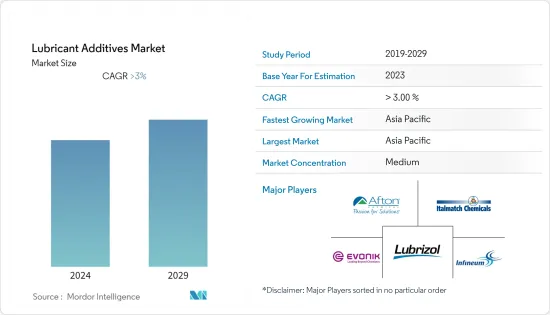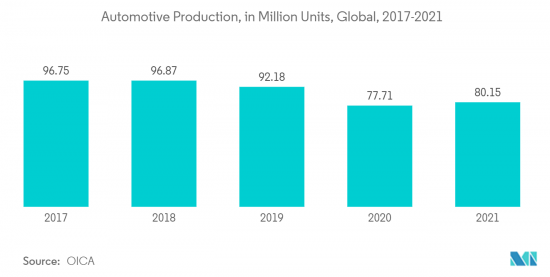PUBLISHER: Mordor Intelligence | PRODUCT CODE: 1404107

PUBLISHER: Mordor Intelligence | PRODUCT CODE: 1404107
Lubricant Additives - Market Share Analysis, Industry Trends & Statistics, Growth Forecasts 2024 - 2029

The lubricant additives market is projected to register a CAGR of over 3% during the forecast period.
The Covid pandemic had a negative impact on the market. COVID-19-related restrictions led to decreased maintenance requirements from several industries. The major impact was observed in the automotive and construction industry, However, the market started growing steadily, owing to increased automotive and construction activities, since 2021.
Key Highlights
- Over the short term, the stringent environmental regulations regarding emissions, and industrial growth in the Middle East and Africa are major factors driving the growth of the market studied.
- However, extended oil change intervals in machinery and automobiles are a key factor anticipated to restrain the growth of the target industry over the forecast period.
- Nevertheless, the growing popularity of high-performance lubricants in Asia-Pacific is likely to create lucrative growth opportunities for the global market soon.
- Asia-Pacific is estimated to witness healthy growth over the assessment period in the lubricant additives market due to the wide usage of lubricants in end-use application segments, such as automotive, and construction due to their desirable properties.
Lubricant Additives Market Trends
Increasing Demand from Automotive and Other Transportation Industry.
- Automotive and other transportation media, such as aircraft and marine, are the largest markets for lubricants.
- Engine designs have been continually improved to enhance performance, increase efficiency, and meet environmental emission regulations.
- Engine oils, gear oils, transmission oils, greases, and compressor oils are the most widely used lubricants in all kinds of automobiles. Lubricants have a good share in the aftermarket and among OEMs.
- Medium-duty and high-performance lubricants are used extensively in vehicle components, such as gears, transmission systems, and engines, which are subjected to high loads and rapid rubbing.
- The automotive industry has been growing rapidly increasing the usage of lubricants and additives, over the past few years, according to OICA, the total production of vehicles (all types) in the year 2021 was 80,145,988 units and registered a growth of 3% when compared to 77,711,725 units in 2020.
- In North America, the United States also has one of the largest automotive industries globally. According to OICA, the automotive production in 2021 accounted for 91,67,214 units, an increase of 4% in comparison to the production in 2020, which was reported to be 88,22,399 units.
- The strong growth of composites in the aerospace industry, particularly in commercial air transport, is poised to lead to changes in corrosion inhibitors and removal fluids.
- Furthermore, according to the International Air Transport Association (IATA), the global revenue for commercial airlines was valued at USD 373 billion in 2020 and was estimated at USD 472 billion in 2021, registering a growth rate of 26.7% Y-o-Y. Furthermore, the revenue is expected to reach USD 658 billion by 2022.
- Recently, aircraft manufacturers are looking for ways to accelerate production to fill order backlogs. For instance, according to the Boeing Commercial Outlook 2022-2041, the total global deliveries of new airplanes are estimated to be 41,170 by 2041. The global airplane fleet amounted to around 25,900 units as of the year 2019 and the fleet number is likely to reach 47,080 units by 2041.
- All the above factors are expected to drive the market for lubricant additives in the coming years.

China to Dominate the Asia-Pacific Region
- In the Asia-Pacific region, China dominated the regional market share. With growing food, and automotive industrial activities.
- China is the leading manufacturer of the automotive industry, According to, OICA, the country has also produced 26,082,220 units of vehicles in 2021, a 3% growth in comparison to the same period last year.
- The food processing industry is moving toward maturity in the country, witnessing moderate growth. Processed and packaged frozen foods are increasingly becoming popular. While in the beverage industry, the trend for the consumption of healthy, natural, and convenient ready-to-drink smoothies, juices, and yogurts has been emerging.
- China is the leading consumer of metalworking fluids. The growth for metalworking is expected to be driven by the robust growth in construction activities and increasing shipbuilding and aircraft orders in the region.
- The Chinese aircraft and spacecraft industry has depicted significant growth over the years. In China, according to the Boeing Commercial Outlook 2022-2041, around 8,485 new deliveries will be made by 2041 with a market service value of USD 545 billion.
- Based on the aforementioned aspects, China is expected to dominate the Asia-Pacific region in the forecast period.
Lubricant Additives Industry Overview
The global lubricant additives market is partially consolidated in nature, The major players include Evonik Industries AG, Italmatch Chemicals S.p.A (The Elco Corporation), Infineum International Limited, The Lubrizol Corporation, and Afton Chemical Corporation, among others (not in any particular order).
Additional Benefits:
- The market estimate (ME) sheet in Excel format
- 3 months of analyst support
TABLE OF CONTENTS
1 INTRODUCTION
- 1.1 Study Assumptions
- 1.2 Scope of the Study
2 RESEARCH METHODOLOGY
3 EXECUTIVE SUMMARY
4 MARKET DYNAMICS
- 4.1 Drivers
- 4.1.1 Stringent Environmental Regulations Regarding Emissions
- 4.1.2 Industrial Growth in Middle-East and Africa
- 4.2 Restraints
- 4.2.1 Extended Oil Change Intervals in Machinery and Automobiles
- 4.3 Industry Value Chain Analysis
- 4.4 Porter's Five Forces Analysis
- 4.4.1 Bargaining Power of Suppliers
- 4.4.2 Bargaining Power of Buyers
- 4.4.3 Threat of New Entrants
- 4.4.4 Threat of Substitute Products and Services
- 4.4.5 Degree of Competition
5 MARKET SEGMENTATION (Market Size in Value)
- 5.1 Product Type
- 5.1.1 Dispersants and Emulsifiers
- 5.1.2 Viscosity Index Improvers
- 5.1.3 Detergents
- 5.1.4 Corrosion Inhibitors
- 5.1.5 Oxidation Inhibitors
- 5.1.6 Extreme-pressure Additives
- 5.1.7 Friction Modifiers
- 5.1.8 Other Functions
- 5.2 Lubricant Type
- 5.2.1 Engine Oil
- 5.2.2 Transmission and Hydraulic Fluid
- 5.2.3 Metalworking Fluid
- 5.2.4 General Industrial Oil
- 5.2.5 Gear Oil
- 5.2.6 Grease
- 5.2.7 Process Oil
- 5.2.8 Other Lubricant Types
- 5.3 End-user Industry
- 5.3.1 Automotive and Other Transportation
- 5.3.2 Power Generation
- 5.3.3 Heavy Equipment
- 5.3.4 Metallurgy and Metal Working
- 5.3.5 Food and Beverage
- 5.3.6 Other End-users Industries
- 5.4 Geography
- 5.4.1 Asia-Pacific
- 5.4.1.1 China
- 5.4.1.2 India
- 5.4.1.3 Japan
- 5.4.1.4 South Korea
- 5.4.1.5 ASEAN Countries
- 5.4.1.6 Rest of Asia-Pacific
- 5.4.2 North America
- 5.4.2.1 United States
- 5.4.2.2 Mexico
- 5.4.2.3 Canada
- 5.4.3 Europe
- 5.4.3.1 Germany
- 5.4.3.2 United Kingdom
- 5.4.3.3 Russia
- 5.4.3.4 Italy
- 5.4.3.5 France
- 5.4.3.6 Rest of Europe
- 5.4.4 South America
- 5.4.4.1 Brazil
- 5.4.4.2 Argentina
- 5.4.4.3 Rest of South America
- 5.4.5 Middle-East and Africa
- 5.4.5.1 Saudi Arabia
- 5.4.5.2 South Africa
- 5.4.5.3 Rest of Middle-East and Africa
- 5.4.1 Asia-Pacific
6 COMPETITIVE LANDSCAPE
- 6.1 Mergers, Acquisitions, Joint Ventures, Collaborations, and Agreements
- 6.2 Market Ranking Analysis
- 6.3 Strategies Adopted by Leading Players
- 6.4 Company Profiles
- 6.4.1 Afton Chemical
- 6.4.2 BASF SE
- 6.4.3 BRB International
- 6.4.4 Chevron Corporation
- 6.4.5 Croda International PLC
- 6.4.6 DOG Deutsche Oelfabrik Gesellschaft fur chemische Erzeugnisse mbH & Co. KG
- 6.4.7 Dorfketal Chemicals (I) Pvt Ltd
- 6.4.8 DOVER CHEMICAL CORPORATION
- 6.4.9 Evonik Industries AG
- 6.4.10 Infineum International Limited
- 6.4.11 Jinzhou Kangtai Lubricant Additives Co. Ltd
- 6.4.12 King Industries Inc.
- 6.4.13 LANXESS
- 6.4.14 Multisol
- 6.4.15 RT Vanderbilt Holding Company Inc.
- 6.4.16 Shepherd Chemical
- 6.4.17 Italmatch Chemicals SpA (The Elco Corporation)
- 6.4.18 The Lubrizol Corporation
- 6.4.19 Wuxi South Petroleum Additives Co. Ltd
7 MARKET OPPORTUNITIES AND FUTURE TRENDS
- 7.1 Growing Popularity of High-performance Lubricants in Asia-Pacific




